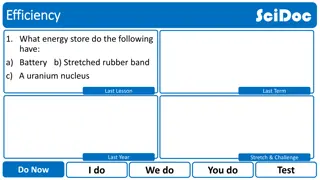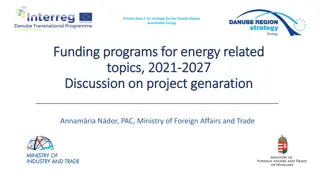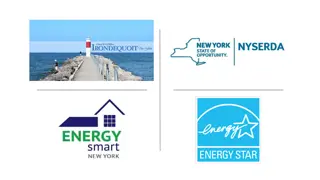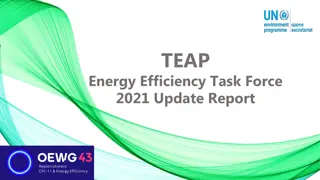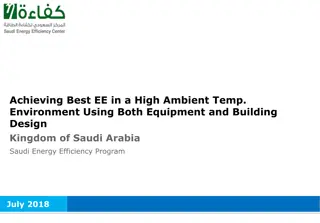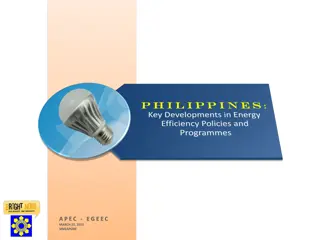Understanding Workpapers in Energy Efficiency Programs
Dive into the world of workpapers in energy efficiency programs, covering topics such as workpaper development, deemed energy efficiency measures, the Database of Energy Efficiency Resources (DEER), and the components that make up a workpaper. Explore why workpapers are essential for providing necessary supporting information and forecasting values in energy efficiency initiatives.
Download Presentation

Please find below an Image/Link to download the presentation.
The content on the website is provided AS IS for your information and personal use only. It may not be sold, licensed, or shared on other websites without obtaining consent from the author. Download presentation by click this link. If you encounter any issues during the download, it is possible that the publisher has removed the file from their server.
E N D
Presentation Transcript
Workpaper Development Training
Presenter Topic Start Time Host IOU Opening & Safety 10:00 CPUC Workpaper History & Regulatory Framework Workpaper Development & Roles 10:10 Martin Vu, RMS 10:40 -- LUNCH 12:00 Martin Vu, RMS Roles (Continued) 12:45 Martin Vu, RMS Process & Timing 1:25 Host IOU IOU Solicitation Workpaper Review Process 2:25 Susan Haselhorst, EAR Commission Workpaper Approval Process 3:25 Ayad Al-Shaikh, CalTF eTRM Demo 4:10
Workpaper History and Regulatory Framework Presented by CPUC California Public Utilities Commission
What is a Workpaper? A workpaper is a technical document that provides all necessary supporting information to develop forecasted values/ savings for deemed energy efficiency measures that are not completely covered by the Database of Energy Efficiency Resources (DEER)
What are deemed energy efficiency measures? Estimates of energy savings for a single unit of an installed EE measure is 1. developed from data sources (such as prior metering studies) and analytical methods 2. applicable to the situation under which the measure is being implemented.
What is DEER? It is the database of energy efficiency resources Database on costs and benefits of energy-efficient measures. What kind of information can you find in DEER? Measure ID/ IOU Energy Impacts Net-to-Gross reference Effective Useful Life (EUL) Gross Savings Adjustment reference (installation rate) Measure Application Type Delivery Type
Components of a workpaper Describes program delivery method Includes engineering calculations Describes baseline and measure technologies Sometimes includes building simulations Outputs energy savings, net-to- gross, effective useful life, measure cost estimates Proposal for new measure Workpaper 7
Why do workpapers matter? Workpapers are the only way program administrators can introduce new deemed measures into the portfolio All deemed measures need an approved workpaper before they can be offered in a program Ex ante estimates from workpapers feed into measure/program/portfolio cost-effectiveness analysis Lessons learned from program implementation and impact and market characterization studies can feed into workpaper updates 8
Purpose of reviewing forecasted savings, including workpapers The program administrators strive to meet energy savings goals that are cost effective on an overall portfolio basis. The program administrators primarily the utilities get credit for energy savings due to their efforts beyond what would have happened if they did nothing. The question is how much did they contribute to obtaining these savings and how much would have happened anyways.
CPUC Regulatory Background CPUC Decision (D.) 09-09-047 Authority to review and approve workpapers Process for submittal, review and freezing of workpaper values. Application 08-07-021 (a Ruling) Phase 1 and Phase 2 reviews and approval for workpapers (11/18/2009) CPUC Decision (D.) 12-05-015 Bus stop schedule Defines interim approval Encourages new measures and follow-up research
More Regulatory Background CPUC Decision (D.) 15-10-028 (Rolling portfolio) Replaced a three year regulatory cycle with an annual cycle Resolution E-4795 (DEER2017/2018 update) New Code Update or Code Update Not Covered in Previous DEER Updates Required changes in workpaper parameters Updates Based on Evaluation Results Resolution E-4952 (DEER2019/2020 update) Updated DEER values including shift in peak power periods Addition of New Measures Required changes in workpaper parameters New Code Update or Code Update Not Covered in Previous DEER Updates Policy Directed Updates Supported by Prior Evaluation Reports and Findings
More Regulatory Background Resolution E-4818 (T1WG) Adopts measure-level baseline assignments Adopts tiered approached to preponderance of evidence (POE) for accelerated replacement baseline treatment but not the proposed T1WG requirements. Resolution E-4939 (T2WG) Adopts the standard practice baseline definition and baseline selection process Adopts a single preponderance of evidence (POE) requirement process for all accelerated-replacement measure types. Adopts a small-sized business customer definition pathway for accelerated replacements.
Why does the Rolling Portfolio Matter to the CPUC workpaper (ex ante) review team? BUS STOPS were adopted in a Commission Decision Define Workload management If we miss the bus stop then wait and get on the next bus stop date
Role of CPUC staff Not to supplement the utility reviewer Review and help improve the PA s internal review efforts to accomplish the Commission s goals: Improving the reliability of the savings estimate Savings are a primary driver of program cost- effectiveness Ensure compliance with CPUC rules and policies 15
CPUC Resources and Information Energy Efficiency CPUC web site http://www.cpuc.ca.gov/egyefficiency/ Ex-ante Review material http://www.cpuc.ca.gov/General.aspx?id=4132
Dispute Resolution Process 1. Disputes over Staff Recommendations - D.12-05-015 (page 335) includes a dispute resolution process a) CPUC staff and PA will meet to reach an agreement (bi-weekly PA and statewide meetings) b) Every six months Commission staff can draft A resolution that identifies disputed values PAs can submit comments on the draft resolution
Dispute Resolution Process 2. Third parties disagree with the program administrators Tap in to resources CALTF, if still no resolution with the PA, then Third Parties can present their case to CPUC (ex ante supervisor and staff lead) CPUC Staff will discuss at the bi-weekly workpaper coordination meeting (Step a- previous slide) Ex ante team s guidance and recommendation will be final until the program administrators submit the workpaper and if there is disagreement, then staff will follow Step b (previous slide).
Industrial/ Agricultural Programs and Portfolio Forecasting Section Ex Ante Staff Lead Peter Biermayer (Deemed) peter.biermayer@cpuc.ca.gov Peter Lai (Custom) peter.lai@cpuc.ca.gov Manisha Lakhanpal (Supervisor) manisha.lakhanpal@cpuc.ca.gov 19
RMS Energy Consulting, LLC Workpaper (WP)Development Training Thursday November 29, 2018 3RD PARTY WORKPAPER DEVELOPMENT TRAINING
RMS Energy Consulting, LLC Agenda Objectives: Introduce 3rd Party Implementers (3Ps) to the tools/information they need to develop their own Workpapers (WPs) Clarify roles & responsibilities around WP development Describe the process and timing for review and approval of 3P WP 3RD PARTY WORKPAPER DEVELOPMENT TRAINING
RMS Energy Consulting, LLC Tools/Information Needed to Develop WPs Thursday November 29, 2018 3RD PARTY WORKPAPER DEVELOPMENT TRAINING
RMS Energy Consulting, LLC You Have an Innovative Idea Now What? HVAC Lighting Technology 1 Technology 2 Plug Load Deemed Innovative Idea Technology 3 Technology 4 Custom 3RD PARTY WORKPAPER DEVELOPMENT TRAINING
RMS Energy Consulting, LLC WP Development Hierarchy Database for Energy Efficiency Resources (DEER) Is there a similar measure in DEER? 1. Existing CPUC Approved Non-DEER WPs Is there an existing Non-DEER WP for this measure? Is it 2. 3rd Party WP Creation creating a new WP or modifying an existing WP? 3. 3RD PARTY WORKPAPER DEVELOPMENT TRAINING
RMS Energy Consulting, LLC 1. What is DEER? DEER Database for Energy Efficiency Resources Administered and Maintained by the CPUC Provides estimates of energy savings potential for typical energy efficiency measures commonly installed in the marketplace URL: http://deeresources.com/ 3RD PARTY WORKPAPER DEVELOPMENT TRAINING
RMS Energy Consulting, LLC 1. What is DEER? DEER Database for Energy Efficiency Resources URL: http://deeresources.com/ DEER prototypes, underlying workbooks and calculators used with MAS Control system for core set of deemed/prescriptive measures READi tool provides an interface to DEER Developed, ran and maintained for the CPUC 3RD PARTY WORKPAPER DEVELOPMENT TRAINING
RMS Energy Consulting, LLC 1. Where to Find DEER References? URL: http://deeresources.com/index.php/deer-versions/readi 3RD PARTY WORKPAPER DEVELOPMENT TRAINING
RMS Energy Consulting, LLC 1. Questions About DEER and REAdi? URL: http://deeresources.com/index.php/deer-versions/readi 3RD PARTY WORKPAPER DEVELOPMENT TRAINING
RMS Energy Consulting, LLC 2. What is an Existing Non-DEER WP Documentation prepared to substantiate the Data, methods, and rational used for ex-ante values Ex-Ante Values: Estimated values used to support energy savings claims before impact evaluation is conducted Non-DEER WPs are generated when DEER values, assumptions and methods are not available URL: http://www.deeresources.net/ 3RD PARTY WORKPAPER DEVELOPMENT TRAINING
RMS Energy Consulting, LLC 2. What is an Existing Non-DEER WP Document Archive of Ex-Ante Resources Workpaper Disposition & Archive Site URL: http://www.deeresources.net/ Inventory of Non-DEER WPs and Dispositions CPUC selects and vets fully developed WPs, then dispositions or approves WP measures sometimes are migrated into DEEER (WP Retired) => Annual DEER Update process impacts both DEER and WPs 3RD PARTY WORKPAPER DEVELOPMENT TRAINING
RMS Energy Consulting, LLC 3. Third Party (3P) WP Creation? Considerations Create New or Modify Existing WP? 1. Was the Hierarchy Followed? 2. Do I have sufficient data to support the wp for consideration? 3. Do I have the resources and expertise to do this? 3RD PARTY WORKPAPER DEVELOPMENT TRAINING
RMS Energy Consulting, LLC 3. Third Party (3P) WP Creation? Considerations Hypothetical 1. Was DEER or CPUC Approved WPs Referenced? 2a. Deviating from DEER or WPs? 2b. Sufficient data to support the wp development? 3a. Appropriate staff and competency to develop the wp? 3b. Outsource? 3RD PARTY WORKPAPER DEVELOPMENT TRAINING
RMS Energy Consulting, LLC Mechanics for Development of Successful WP Statewide WP Templates and Tools Word Document Excel Data Spec QA/QC Checklist PG&E Rulebook 3RD PARTY WORKPAPER DEVELOPMENT TRAINING
RMS Energy Consulting, LLC Important Note: Measure Application Type (MAT) A categorization of energy efficiency measures based on measure attributes Each MAT has its own baseline treatment, cost basis, eligibility, and documentation requirements. There are six approved measure application types, which include: 1. 2. 3. 4. 5. 6. Accelerated Replacement Add-On Equipment Behavioral, Retrocommissioning and Operational (BRO) New Construction/New Capacity, Normal Replacement Weatherization 3RD PARTY WORKPAPER DEVELOPMENT TRAINING
RMS Energy Consulting, LLC Important Note: Measure Application Type (MAT) Resolution E-4818. Measure level baseline assignment and preponderance of evidence (POE) guidance to establish eligibility for an accelerated replacement baseline treatment 3RD PARTY WORKPAPER DEVELOPMENT TRAINING
RMS Energy Consulting, LLC Walk Thru of Normal Replacement (NR) Example Thursday November 29, 2018 3RD PARTY WORKPAPER DEVELOPMENT TRAINING
RMS Energy Consulting, LLC Example Normal Replacement Measure MAT: Normal Replacement (NR) Formerly Known as Replace on Burnout (ROB) A majority of the deemed portfolio offering wps support this MAT Example WP: Commercial Foodservice: Griddles 3RD PARTY WORKPAPER DEVELOPMENT TRAINING
RMS Energy Consulting, LLC Example Normal Replacement Griddle Measure MAT: Normal Replacement (NR) Includes measure installations where the existing equipment has failed or no longer meets current or anticipated needs or is being replaced due to remodeling, upgrading, or replacement activities that are undertaken in the normal course of business. Measure installations where the existing equipment is still functional but does not qualify for Accelerated Replacement fall into this category. Commercial Foodservice Griddles are NR measures 3RD PARTY WORKPAPER DEVELOPMENT TRAINING
RMS Energy Consulting, LLC Walk Thru of Normal Replacement (NR) Example Data Fields Thursday November 29, 2018 3RD PARTY WORKPAPER DEVELOPMENT TRAINING
RMS Energy Consulting, LLC Example Normal Replacement Griddle Measure (SUMMARY) Building Type: Any Refers to applicable building types Building Vintage: Any Refers to the applicable building vintage year Building Location: Any Refers to the applicable CEC Climate Zones EUL ID: Cook-ElecGriddleCook-GasGriddle Refer to the DEER Database EUL Support Tables RUL ID: N/A Refer to the DEER Database EUL Support Tables 3RD PARTY WORKPAPER DEVELOPMENT TRAINING
RMS Energy Consulting, LLC Example Normal Replacement Griddle Measure Building Type: Any Workpapers must indicate which building types are eligible for the measure and include the associated savings for each eligible building type. Eligible DEER building types can be found in the READI database. New building types may be proposed to the CPUC for consideration. Refers to applicable building types 3RD PARTY WORKPAPER DEVELOPMENT TRAINING
RMS Energy Consulting, LLC Example Normal Replacement Griddle Measure Building Vintage: Any Refers to the applicable building vintage year Building Location: Any Refers to the applicable CEC 16 Climate Zones Normal Unit: Len-Ft. Refers to applicable cost and energy common unit type. 3RD PARTY WORKPAPER DEVELOPMENT TRAINING
RMS Energy Consulting, LLC Example Normal Replacement Griddle Measure Effective Useful Life (EUL ID): Cook-ElecGriddleCook- GasGriddle An estimate of the median number of years that the measures installed under the program are still in place and operable. Refer to the DEER Database EUL Support Tables RUL ID: N/A An estimate of the median number of years that a measure being replaced under the program would remain in place and operable had the program intervention not caused the replacement. Refer to the DEER Database EUL Support Tables 3RD PARTY WORKPAPER DEVELOPMENT TRAINING
RMS Energy Consulting, LLC Example Normal Replacement Griddle Measure Net to Gross Ratio (NTGR): Com-Default> 2yrs A ratio or percentage of net program impacts divided by gross or total impacts. Net-to-gross ratios are used to estimate and describe the free-ridership that may be occurring among energy efficiency program participant. Refers to appropriate net-to-gross ratio in DEER READI 3RD PARTY WORKPAPER DEVELOPMENT TRAINING
RMS Energy Consulting, LLC Example Normal Replacement Griddle Measure Delivery Channel: PreRebUp Upstream rebate goes to the manufacturer Type of program delivery in which an incentive goes to the manufacturer to encourage production and promotion of energy efficiency products in the market. Incentive may or may not be passed to the end-use customer Delivery Channel: NonUpStrm Midstream rebate goes to the retailer Type of program delivery in which incentive goes to the distributor or retailer to encourage promotion of energy efficiency products in the market. Incentive may or may not be passed to the end-use customer. Incentive may or may not be passed to the customer. Does not include programs partnering with contractors or installers 3RD PARTY WORKPAPER DEVELOPMENT TRAINING
RMS Energy Consulting, LLC Example Normal Replacement Griddle Measure Delivery Channel: PreRebDown Downstream rebate goes to the end use customer Classification of program delivery in which program is delivered by agents or representatives (including installation contractors) that have direct interaction with end-use customers or through a program website. Delivery Channel: DirInstall Direct Install Labor and material costs goes to the implementer Energy efficiency solutions provided directly to the customer at little or no cost through installation contractors provided and managed by an Implementer 3RD PARTY WORKPAPER DEVELOPMENT TRAINING
RMS Energy Consulting, LLC Example Normal Replacement Griddle Measure Gross Savings Installation Adjustment (GSIA): Def-GSIA The GSIA is a DEER adjustment factor that combines the Realization Rate and Installation Rate. It is dependent on both the measure technology and how the measure is delivered and represents the percentage of units for which incentives were paid but not installed. The default is typically 1.0 unless an ex-post impact evaluation, disposition, resolution or DEER Update indicate otherwise 3RD PARTY WORKPAPER DEVELOPMENT TRAINING
RMS Energy Consulting, LLC Example Normal Replacement Griddle Measure Electric and Gas Load Shapes: Commercial Griddle Electric: Currently varies by PA Commercial Griddle Gas: Annual Load shapes are used for portfolio lifecycle cost analysis. A load shape indicates the distribution of a measure s energy savings over one year. A load shape is a set of fractions summing to unity, with one fraction per hour (or other time period). Multiplying a savings value by the load shape value for any particular hour yields the energy savings for that particular hour. Implementers may use and report only load shapes provided in DEER. Alternatively, a weighted blend of DEER load shapes based on metered data may be calculated and provided. 3RD PARTY WORKPAPER DEVELOPMENT TRAINING
RMS Energy Consulting, LLC Example Normal Replacement Griddle Measure Sector: Ag, Com, Ind Customer groups sharing common characteristics and barriers that are building blocks to each Program Administrators portfolios including: 1. 2. 3. 4. 5. 6. Residential (Res) Commercial (Com) Public (Pub) Industrial (Ind) Agricultural (Agr) Cross-Cutting (CC) PA/POU: Any Identifies applicable program administrators participating in this deemed measure. Bldg HVAC: Any Identifies applicable HVAC system for that building type Refer to the DEER Database for applicable HVAC systems 3RD PARTY WORKPAPER DEVELOPMENT TRAINING
RMS Energy Consulting, LLC Example Normal Replacement Griddle Measure Hours of Use (HOU): Blank For applicable measures (i.e. lighting), hours of use or operation are documented. Use the operating hours values and methods from the most recent version of DEER if the measure values are available. Interactive Effect (IE) Factor: No The secondary energy and demand impacts that result from a measure to a or Interactive Effects secondary system or equipment not directly involved in the retrofit activity (e.g., cooling or heating energy impacts resulting from the installation of efficient lighting fixtures). Interactive Effects Table Name: Blank Identify the applicable IE table name, otherwise if not applicable leave blank. 3RD PARTY WORKPAPER DEVELOPMENT TRAINING






